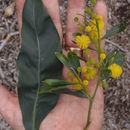Brief Summary
provided by EOL authors
Acacia pycnantha (golden wattle) was adopted as Australia's official floral emblem during the bicentenary year in 1988. Designs based on the golden wattle appear in the Australian Coat of Arms, the decoration for the Order of Australia, and the crest of the Governor-General of Australia, and have appeared on numerous commemorative postage stamps. The green and gold colors used by Australia’s international sporting teams were likely inspired by wattles in general. A. pycnantha is a 2–8 m tall short-lived tree or shrub with generally smooth, dark brown to grey bark. The mature trees do not have true leaves but have long, sickle-shaped phyllodes—structures in which the leaflets are suppressed, and the leaf-stalks (petioles) become vertically flattened, and serve the purpose of leaves. (The vertical orientation of the phyllodes protects them from intense sunlight: with their edges towards the sky and earth they do not intercept as much light as horizontally placed leaves.) The phyllodes are shiny, dark green, 8–20 cm long and 0.5–3.5 cm wide. A. pycnantha flowers in late winter and spring, producing a mass of fragrant, fluffy, golden flowers. The rounded inflorescences are bright yellow and occur in axillary racemes or terminal panicles in groups of 4–23. These are followed by flattish, straight or slightly curved pods, 5–14 cm long and 0.5–0.8 cm wide. A. pycnantha was first formally described by botanist George Bentham in the London Journal of Botany in 1842. The specific epithet, “pycnantha,” is derived from the Greek words “pyknos” (dense) and “anthos” (flowers), a reference to the dense cluster of flowers that make up the globular inflorescences. In its native range in Australia, golden wattle is found in the understory of open eucalypt forests on dry, shallow soils. It has been cultivated and is naturalized throughout all the southern states of Australia. It was introduced to the northern hemisphere in the 1800s. It has a degree of frost tolerance and is adaptable to a wide range of soil conditions, so it has been grown in temperate regions around the world. It is used for commercial production of tannins (used in tanning leather); its bark produces the highest yield of all the wattles. It has been planted as an ornamental for its bright yellow, scented flowers, which have been also used for making perfume. It has naturalized and is considered a Category 1 invasive in South Africa (invader plants must be removed and destroyed immediately, SANA 2011). Although it has also naturalized in California, it is not yet among the Acacia species that considered an invasive threat there by the California Invasive Plant Council (Cal-IPC 2011).
- license
- cc-by-nc
- copyright
- Jacqueline Courteau, modified from Wikipedia

